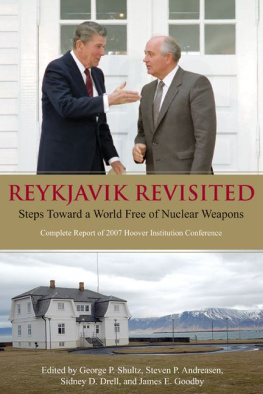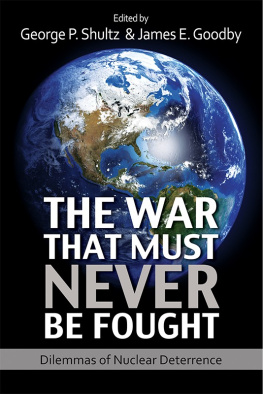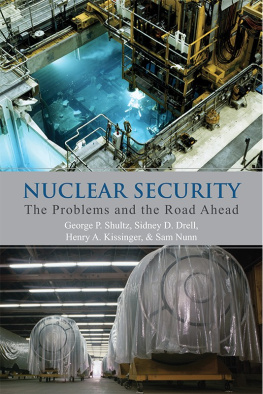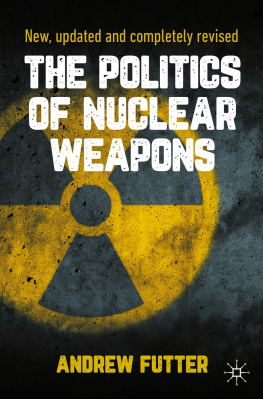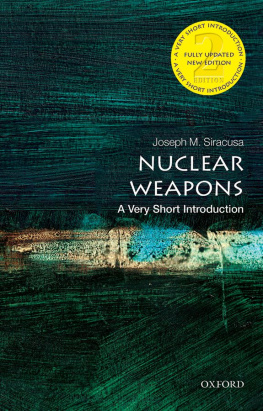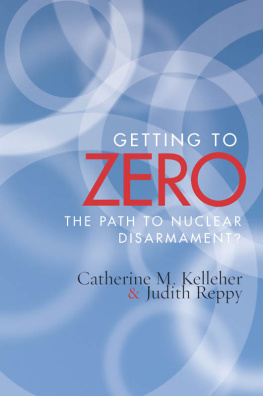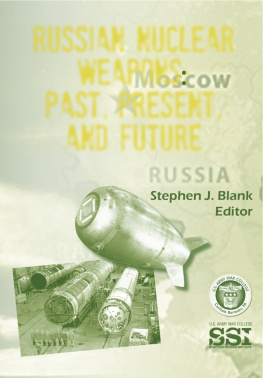THE JOHN D. AND CATHERINE T. MACARTHUR FOUNDATION
and
THE WILLIAM AND FLORA HEWLETT FOUNDATION
REYKJAVIK REVISITED
Steps Toward a World Free of Nuclear Weapons
Complete Report of 2007 Hoover Institution Conference
Conference Report Editors
George P. Shultz, Steven P. Andreasen, Sidney D. Drell, and James E. Goodby
Conference Sponsored by the HOOVER INSTITUTION and the NUCLEAR THREAT INITIATIVE

HOOVER INSTITUTION PRESS
Stanford University
Stanford, California
The Hoover Institution on War, Revolution and Peace, founded at Stanford University in 1919 by Herbert Hoover, who went on to become the thirty-first president of the United States, is an interdisciplinary research center for advanced study on domestic and international affairs. The views expressed in its publications are entirely those of the authors and do not necessarily reflect the views of the staff, officers, or Board of Overseers of the Hoover Institution.
www.hoover.org
The Nuclear Threat Initiative (NTI) is a non-profit organization with a mission to strengthen global security by reducing the risk of use and preventing the spread of nuclear, biological and chemical weapons, and to work to build the trust, transparency and security which are preconditions to the ultimate fulfillment of the Non-Proliferation Treaty's goals and ambitions.
www.nti.org
Hoover Institution Press Publication No. 565
Hoover Institution at Leland Stanford Junior University,
Stanford, California, 94305-6010
Copyright 2008 by the Board of Trustees of the Leland Stanford Junior University
All rights reserved. No part of this publication may be reproduced, stored in a retrieval system, or transmitted in any form or by any means, electronic, mechanical, photocopying, recording, or otherwise, without written permission of the publisher and copyright holders.
First printing 2008
15 14 13 12 11 10 09 08 9 8 7 6 5 4 3 2 1
Manufactured in the United States of America
Library of Congress Cataloging-in-Publication Data
Reykjavik revisited : steps toward a world free of nuclear weapons / edited by George P. Shultz... [et al.].
p. cm. (Hoover Institution Press publication series ; 565)
Includes bibliographical references and index.
ISBN: 978-0-8179-4921-1 (hardback : alk. paper)
ISBN: 978-0-8179-4922-8 (pbk. : alk. paper)
1. Nuclear proliferationCongresses. 2. Nuclear arms controlCongresses. I. Shultz, George Pratt, 1920 .
JZ5675.R49 2008
327.1'747dc22 2008015427
ISBN 978-0-8179-4923-5 (electronic)
Contents
George P. Shultz, Steven P. Andreasen, Sidney D. Drell, and James E. Goodby
Steven P. Andreasen
David Holloway
Bruce G. Blair
Rose Gottemoeller
Raymond J. Juzaitis and John E. McLaughlin
Matthew Bunn
Edward Ifft
Matthew Bunn
Robert J. Einhorn
James Timbie
James E. Goodby
Raymond Jeanloz
Jack F. Matlock Jr.
Max M. Kampelman
Max M. Kampelman and Steven P. Andreasen
James E. Goodby and Sidney D. Drell
George P. Shultz and Henry S. Rowen
George P. Shultz, William J. Perry, Henry A. Kissinger, and Sam Nunn [ Wall Street Journal op-ed, January 4, 2007]
George P. Shultz, William J. Perry, Henry A. Kissinger, and Sam Nunn [ Wall Street Journal op-ed, January 15, 2008]
Preface
George P. Shultz
Steven P. Andreasen
Sidney D. Drell
James E. Goodby
This book is a report on an extraordinary conference.
The papers included here were presented at a conference held at Stanford University's Hoover Institution in collaboration with Sam Nunn's Nuclear Threat Initiative (NTI) on October 2425, 2007. The topics emerged from discussions of a January 2007 essay in the Wall Street Journal in which the many signatories agreed to a central argument for rekindling the bold vision of a world free of nuclear weapons that Ronald Reagan and Mikhail Gorbachev brought to their 1986 meeting in Reykjavik. It is that a powerful synergy can be developed if the goal of a world without nuclear weapons is linked to the individual actions needed to move the world toward that goal. There is more political force in these ideas if they are considered as one program rather than as discrete entities. Without that vision, which has faded since that dramatic encounter in Reykjavik, measures that could provide greater safety to all the world's peoples have not been pursued with the intensity the times require. As recorded in this volume, the 2007 conference emphasized the importance of these measures.
The papers were prepared by highly qualified individuals, and they were reviewed and worked over by their colleagues and discussed in some detail at the conference. Each writer then had an opportunity to make whatever additions and revisions seemed appropriate. The result appears here.
Work continues to go forward on all of these steps toward a world free of nuclear weapons, steps which, in and of themselves, are vital to achieving a safer world. Many canand shouldbe implemented or acted upon promptly.
The papers develop three main themes: practical ways to remove nuclear warheads from the world's inventories of ready-to-fire weapons and ultimately to eliminate them; methods to manage and control nuclear programs to ensure that nuclear materials are used only for peaceful purposes; and technical, political, and intelligence issues that must be considered in reducing incentives for acquiring nuclear arsenals and in creating a global coalition in support of a world free of nuclear weapons.
The number of nuclear warheads held by the United States and Russia has decreased significantly since 1986, and the number of states that have opted to develop nuclear weapons and maintain them in their arsenals still remains under ten. However, the international consensus that favored fewer, rather than more, nuclear weapons states has eroded. Some states that decided to forgo nuclear weapons, thinking that their national security could be protected without them, reportedly are reconsidering their positions, and more will do so, inevitably, if present trends persist. Moreover, with the global spread of technology, the threat that the world's most terrible weapons might fall into dangerous hands, including terrorist organizations, has grown.
In short, the situation that has developed in recent years is not favorable to nonproliferation efforts. Changing that will require nothing less than a new deal between the states that have nuclear weapons and those states that, for now, have volunteered to forgo their right to acquire them. It also has to be recognized that the path ahead is deeply entwined with, and dependent upon, political cooperation on a global scale and with nations of varying patterns of governance. The vision of Reykjavik is an essential part of the process. Unless this bold vision is embraced, individual steps along the way are unlikely to be perceived as fair or urgent. Rather, they would be seen as preserving the current situation of a two-tier system in which a small number of states possess nuclear weapons and all others must remain without them. This concept becomes less and less viable as nuclear technology and knowledge spread throughout the world.
Will this task be difficult? Yes, without a doubt. It will be especially daunting to eliminate all non-deployed warheads because the verification challenges are enormous. But with success in reducing operationally deployed warheads to zero on a global basis, the necessary experience and the mutual trust to proceed toward the elimination of all nuclear weapons should develop, making feasible the verification procedures that now appear to be so difficult.

